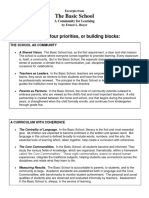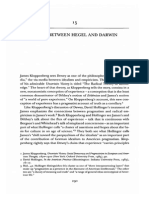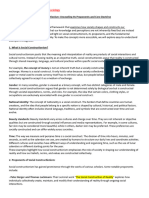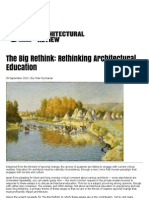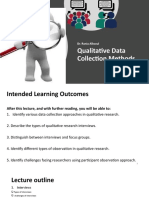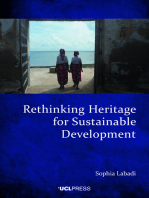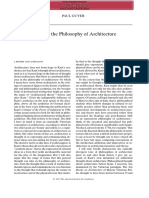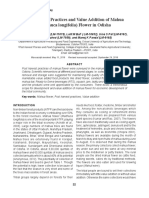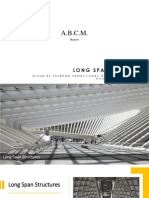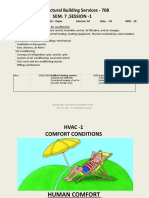The Importance of Human Experience in Architectural Design
The Importance of Human Experience in Architectural Design
Uploaded by
Amey DeshmukhCopyright:
Available Formats
The Importance of Human Experience in Architectural Design
The Importance of Human Experience in Architectural Design
Uploaded by
Amey DeshmukhCopyright
Available Formats
Share this document
Did you find this document useful?
Is this content inappropriate?
Copyright:
Available Formats
The Importance of Human Experience in Architectural Design
The Importance of Human Experience in Architectural Design
Uploaded by
Amey DeshmukhCopyright:
Available Formats
See discussions, stats, and author profiles for this publication at: https://www.researchgate.
net/publication/326631961
The Importance of Human Experience in Architectural design
Article · July 2018
CITATIONS READS
3 3,786
2 authors:
Arga Patria Yulia Lukito
University of Indonesia University of Indonesia
3 PUBLICATIONS 3 CITATIONS 24 PUBLICATIONS 29 CITATIONS
SEE PROFILE SEE PROFILE
Some of the authors of this publication are also working on these related projects:
Architect and Empathy : The Importance of Human Experience in Architectural design View project
Empathy And Architecture View project
All content following this page was uploaded by Arga Patria on 17 August 2018.
The user has requested enhancement of the downloaded file.
International Journal of Built Environment and Scientific Research Volume 02 Number 01 | June 2018
p-issn: 2581-1347 | e-issn: 2580-2607 | Pg. 47-54
[Blank 14]
[Blank 14]
Architect and Empathy:
The Importance of Human Experience in Architectural design
[Blank 12]
Arga Patria
Dranie Putra1 and Yulia Nurliani Lukito2
1
Postgraduate Student, Departement of Architecture, Faculty of Engineering Universitas Indonesia, Indonesia
2
Lecturer, Departement of Architecture, Faculty of Engineering Universitas Indonesia, Indonesia
Email address of corresponding author: argadranie@outlook.com and yulianurliani@yahoo.com
[Blank 10]
ABSTRACT
Architecture usually pursued as a response to human needs, a need for shelter, security, fellowship, etc. For the
last couple of decades, the criticism of architecture for being emotionally cold starts to emerge, accused of
creating distance between human from the life. As Jullio Pallasma said, the emotional coldness might be caused
by the adoption of formalist attitude since the industrial revolution. Modernism arguably, have brought an
ideology which focused on function and aesthetic into architecture, but the notion also resulting in a far less
empathic architectural. The building becomes apathetic, as function and aesthetic pushed aside the liveliness
context. Designs are becoming less authentic, as architects prefer to use existing data to save their time. In short,
it can be said that the presence of empathy has far been less acknowledged as an essential aspect of architecture.
To address the notion of the problems, This paper will examine the terms of empathy, As understanding, the
terms would provide more information about how it could relate to architecture. Further extensions of the notion
will be explored, based on the existing precedents which already points out the presence of empathy-related
topics in architecture. The paper will later examine the relevance of these examples to architecture and claim
what defines the scope of “empathy” in this particular context to help understand it’s potential use in
architecture.
© 2018 IJBESR. All rights reserved.
[Blank 10]
Keywords: Architect, Empathy, Human, Experience, Architectural.
[Blank 10]
[Blank 10]
[Blank 10]
1. Introduction MIT School Of Architecture. We can say that
the opening of the School, can be regarded as a
From being a part of Brunelleschi’s Fine Arts point in the history where architecture starts
in the renaissance era, into a process that being acknowledged as a more complex and
incorporates technology such as in Bauhaus Art important field of study. Furthermore, as the
School’s designs, architecture has gone through development goes, Architecture become more
a long way of development. Indeed, a ‘form of diverse as the architect tried to incorporate
Arts’ and a ‘works of technology’ seems a little more ideas and ideology into it. Say,
too far from being related, but then it proves Structuralism, Deconstruction, and many
that architecture in a broader sense is diverse. others, which become good examples of how
Even until these days architecture is still being extensive and diverse architecture can be.
discussed in many discourses, it is slowly
adapting to the latest findings, mention Despite the great diversity in its development,
Interactive Architecture [1] or Discussions Architecture has Undeniably proven that
About Political Architecture [2]. failures also took part in it. Take a Look at
famous architect such Le Corbusier with his
In the late nineteenth century, architecture had ‘Ville Radieuse’ (also known as a radiant city).
its first formal curriculum by the opening of
Arga Patria Dranie Putra, Yulia Nurliani Lukito | 47
International Journal of Built Environment and Scientific Research Volume 01 Number 01 | June 2017
e-issn: 2580-2607 | Pg. 47-54
Le Corbusier’s Radiant city seems great and aesthetic become the foremost criteria that were
optimistic on the surface, which explains why it being focused. Designs are becoming less
became the model for most of the twentieth- authentic, as architects prefer to use data from
century urban city development. Unfortunately, books such as Time Saver to save their time.
most of the development such Communal And a more similar case can be found which
Housing or Projects-which based on Ville follows the same pattern and resulting tendency
Radieuse got the reputation as places of crime to neglect empathy towards the human who will
and poverty. Mention the infamous Pruitt-Igoe use the building in the future.
Housing Complex, for example, the housing
which based on Ville Radieuse simply prove In some way, ‘being empathic’ seems to be a
the notion mentioned was a result of Ville queasy-necessary, an important yet being taken
Radieuse misinterpretation. The point is, for granted by a designer. Sure, most of the
architects are no more than just mere human times a design could functionally work for most
being, thus failures undoubtedly also become basic requirements, but in some other, a design
part of architectural studies. turns out to be nothing but a blunder. A public
pathway can exist yet never being used, or an
Most of the time, architecture is something that accessible design seems to fulfill the
pursued as a response to a need: a need for requirement but turns out to be harsh for
shelter, security, fellowship, work, healing, or disables. Neglecting of user experience would
learning. Architecture also can be regarded as a end up either being threatened as an
field that exists to fulfill human needs, so in unnecessary or even being a burden for users.
order to design an architectural objects
(landscape, building, interiors) where ‘Human’ This paper aims to examine the terms of
is the center of design thinking in the pursuit to empathy thoroughly, As understanding the
fulfill human needs-, understanding Human terms would provide more information about
emotions, behavior, feelings, and experiences how it could relate to architecture. Further
are undeniably necessary. But, that’s not always extensions of the notion of empathy will be
been the case for contemporary architecture, a explored, depending on the status of the persona
Finnish architect Juhani Pallasmaa have Said : reached through empathy, and on the perceived
representational state of the object. The paper
“Contemporary architecture has often been will later examine the relevance of these
accused of emotional coldness, restrictive examples to architecture and claim what defines
aesthetics and a distance from life. This the scope of “empathy” in this particular
criticism suggests that we architects have context to help understand it’s potential use in
adopted formalist attitudes, instead of tuning architecture.
our buildings with realities of life and the
human mind[...]” 2. Material and Methods
The criticism about architecture being Sympathy and Empathy
emotionally cold can be regarded as the long-
lasting adoption of functionalism. As recorded The term ‘Sympathy’ and ‘Empathy’ were
in history, the architect starts to design often being confused by its meaning. Sure, most
buildings as practical as possible since the of the people probably can easily recall what the
industrial revolution, especially when the terms mean. Averagely, the confusion about the
phenomenon of ‘Mass Production’ was taken terms still can be easily found. Defining both of
into account. An architectural building the terms is something important, yet the
becomes less emotional, as function and emphasize on the difference rarely being
48 | Arga Patria Dranie Putra, Yulia Nurliani Lukito
International Journal of Built Environment and Scientific Research Volume 02 Number 01 | June 2018
p-issn: 2581-1347 | e-issn: 2580-2607 | Pg. 47-54
pointed out. According to Merriam-webster
[3], The word ‘Sympathy’ emerged around Take the usage of ‘Condolence’ for examples.
1970’s, and the terms were mean “Affinity Imagine a situation where an acquaintance (A)
between certain things” taken from Middle lost one of his related (C)-which not well
French Sympathy, and directly from Late Latin known to (B)-, and B would then later offer
Sympathia which means Community of condolence to A as in “I Offer my condolence
Feelings. On the other hand, ‘Empathy’ for the lost of your brother.” B do felt sorry for
modeled on German Einfühlung (from ein “in” A because B know how it feels to lose someone
+ fühlung “feeling”), that was coined 1858 by in his life (D). But what happens to A doesn’t
German philosopher Rudolf Lotze (1817-1881) necessarily the same to B, he did know how it
as a translation of Greek empatheia “passion, feels to lose someone, but it is not as the same
state of emotion.” It is a term from a theory of as what A feels when he lost C. What happens
art appreciation that maintains appreciation is that B Perceive what happens to A, by
depends on the viewer’s ability to project his referring to the moment when he lost D. But this
personality into the viewed objects. is not what is called empathic, this is what it
means to be sympathetic, perceiving how
Regarding sympathy and empathy, Vitoria another human-being felts by recalling to
Gallese explain both of the terms by citing his/her own reference of experience. It is more
Edith Stein's dissertation. Steins explain both of a semiotics kind process. Empathic, on the
terms by: “One cannot be sympathetic without other hand, is somehow more complicated than
being empathetic, but one can be empathetic just that. For B to be empathic, it means that he
without being sympathetic.” According to the needs to feel as what A feel, as if B actually
cited words alone, both of the terms should be experience what A feel, if B has the same
understood as related regarding its usage, rather connection to C just like A did, etc.
than treating both as a separated entity. Stain,
also explain that for one to be Sympathetic is In the context of architecture, the same analogy
means to feel for someone, while being can be applied. Let's say if A is the client and B
empathic were mean to feel With someone. is the architect, while C is the house that A
Edith Stein’s take on both of the terms is the wants B to make. B sure know what house is
notion that sympathy is experienced through the supposed to be, as an architect B could have his
perception of similarity from another human own house, or even have the experience of how
being, while empathy “[…]is by no means to build a house. B would later perceive what A
confined to emotion and feelings, but also want by referring to his personal experience
incorporates action.” either as an architect, or someone who ever
being in a house. He then would proceed to
In a broader sense, Sympathy can be understood design by using those experience to built a
as a perception of another human being by house as requested. Now this is being
referring to a similar former relation that some sympathy, to be empathic, B has to put his own
people ever had. Thus, it means that sympathy feet on A’s shoes, or in short, tried to
can be regarded as ‘understanding the feelings experience like how A would, not simply
of another human being.’ Empathy, on the other interpret how A would do.
hand, can be understood as a similar-yet-
different- process that incorporates actions. By Normally, both of the terms will be regarded as
actions, it means that in some way one person something meta, a process that can not be
can feel how another person is feeling, as in if defined by science, things that cannot be
you can feel the itches when you see another understood as something that is scientific. In
person being pinched on the skin. fact, the process of empathy alone can be
Arga Patria Dranie Putra, Yulia Nurliani Lukito | 49
International Journal of Built Environment and Scientific Research Volume 01 Number 01 | June 2017
e-issn: 2580-2607 | Pg. 47-54
regarded as a complex process of actions that Artistic works have the value that is
can be scientifically explained. Although to do experientially, and emotively real. Works of art
so, incorporating more than one fields of study are not symbols or metaphors of something
are required. In the next section, the process of else. They are authentic experiential reality
empathy will be explored. The scope will themselves. In fact, all art exists in two kind of
revolve around ‘why someone can undergo the realms, that of physical matters and execution
process?” “what perception that cause the as that of mental imagery.
actions, and how it could happen to someone?”.
In short, understanding the process of empathy. In the 1960s, psychologists observed that the
behavior of an individual varied more in diverse
Human Experiences and Perceptions settings than the behavior of other subjects in
the exact setting. The notion of “situational
In the process of designing physical spaces, we personality” was introduced to describe this
are also doing design or implicitly specifying condition [5]. Environments give rise to
distinct experiences, emotions, and mental permanent structural changes in our brain and
states. In fact, in some way, architects are neural systems. In his book Survival Through
operating in the human brain and nervous Design, Richard Neutra already professed.
system. Science has established that
environments could affect our brain, changing The experience of architecture, from the
it, and those changes, in turn, alter human contemplative observation of decoration on a
behavior [4]. It can be said, that the connection Greek temple to the physical experience of
between physical sets and human minds, is living and working within a specific
playing a more significant role then what we architectonic space, can be unpacked or
expect it would be. Playing one particular role deconstructed into its bodily-grounded
that created ‘Human Experience’ in built elements. As Pallasma [6] Said in Empathy and
environments. Architecture seminar: “The constant weighing
of architectonic and peripersonal space is
Architecture, give everyday experiences in the mainly processed by premotor neurons which
way of being specific about perceptual frames map visual space on potential action or motor
and horizon of understanding. Every space, schemata. Cognitive neuroscience can
place, and situation is tuned in a way which can investigate what the sense of the presence of a
project atmospheres that promote distinct building is made of. This approach can also
moods and feelings. We live in resonance with contribute a fresher empirical take on the
the world around us, architecture then manages evolution of architectonic style and its cultural
to mediate and maintains the particular diversity, viewing it as a particular case of
resonance. Architecture qualities are symbolic expression.
constituted in the act of experiencing the work,
which can be related to what philosopher John Adolf von Hildebrand, a sculptor yet also a
Dewey argued about works of art in general : Theoretician, proposed that human is having
responses to art which directly relates space to
“By common consent, the Parthenon is a great move. Furthermore, to understand an artistic
work of art. It has aesthetic standing only as the image means to grasp its creative process
work becomes an experience for a human being within. As Kant suggested, prior experiences
(…) Art is always the product inexperience of did not consist of space, but itself is a product
interaction of human beings with their from that experience. Images are effectual,
environment.” which means they are the outcome of both the
50 | Arga Patria Dranie Putra, Yulia Nurliani Lukito
International Journal of Built Environment and Scientific Research Volume 02 Number 01 | June 2018
p-issn: 2581-1347 | e-issn: 2580-2607 | Pg. 47-54
artist’s creative production and the effects that to be? This kind of problem, in many cases, can
images produce. be regarded as “lacks of empathy,”
Through movement, elements in space can be
connected. Objects were carved out from the It is usually understood, that a sensitive
background and perceived as what it is. designer imagines the acts, experiences, and
Through the movement, representations and feelings of the user of the space. But to say that
meaning are formed and articulated. So it is the way to be empathic in the process of
theoretically, for an architect to fully designs, are most likely improper. According to
understand how a person experiences built Pallasma, the designer usually places
environment, he/she need to simulate as if they him/herself in the role of the future dweller and
are the client. Thus, to fulfill the outcomes that tests the validity of the ideas through this
were required, one’s have to reverse the process imaginative exchange of roles and
of these experiences, so that the user would personalities. Thus, the architect is bound to
understand the intended purpose of the design. conceive the design essentially for him/herself
as the momentary surrogate of the actual
3. Results and Discussions occupant. Without usually being aware of it, the
designer turns into a silent actor on the
Although the phenomenon of modernism imaginary stage of each project.
occurred around nineteenth and twentieth
century, the ideology to focus on function and In the field of design studies, empathy actually
aesthetics seems to last even until these days. It has ever been used as the foremost matter.
can be implied that modernism has brought Mention empathic design by Rayport and Alain
ideologies which focused on function and De Botton [7]. The foundation of the empathic
aesthetic into architecture. Pallasma said that design was mainly to identify latent customer
this may simply because it is easier to imagine needs to create products that the customer most
geometric shapes rather than to capture the likely even know they desire. In some case, the
shapeless and dynamic act of life and the empathic design was also being used to look for
ephemeral feelings evoked by architecture. To a solution that the customers have difficulty
be fair, most of us (architects) choose to rely envisioning due to the lack of familiarity the
upon our self to ‘data’ in a design process, possibilities offered by the new technology
rather than to gather specific information because they are locked in an old mindset.
regarding the particular human who will use the While in architecture, the usage of empathic
building. design such as 21 house in Osaka, were rarely
can be found.
Sure, it comes in handy to design a house by
using standards that are available, But it Discussions that can be related to the presence
becomes a matter when architects rely upon of empathy-yet not being referred as empathy-
themselves only to the data, and neglect what actually can be found in some architectural
human actually needs in the process of design. studies. The studies or notion where human
Let us say that a 3x3 meters space are the experience being put as the main concern, how
standard for a waiting room to accommodate people interprets and perceive were actually
five average people. But imagine, if the most being discussed over and over again in
use of the room is twice as big as the average architecture. Mention ‘Architecture of
person? The room probably can still Happiness’ by Alain de Botton, or
accommodate its requirement, but can the user ‘Atmosphere’ by Peter Zumthor [8].
feel as comfortable as what the room was meant
Arga Patria Dranie Putra, Yulia Nurliani Lukito | 51
International Journal of Built Environment and Scientific Research Volume 01 Number 01 | June 2017
e-issn: 2580-2607 | Pg. 47-54
Philosopher Alain de Botton tells a story In The presence of human experience is an essential
Architecture of Happiness, about how we tend part of the architecture. Arguably, if one wants
to perceive buildings and people in similar to design a built environment which gave the
terms empathy into parallel concepts with the sense of happiness as what Botton tell, or
specific vocabulary. He explores how humans having the excellent Atmosphere as Zumort
tend to experience architecture regarding refer to, human experience is one that needs to
individual selves; using his words, refers to be put on the foremost, while to achieve that
what we call things “happy” that make us empathy is one parameter that can be used to
happy. In addition to architecture, the idea is identify the requirements.
equally applicable to landscapes and cityscapes
and to everyday objects which given 4. Conclusion
personalized names – such as dorms or cars.
The point is not, of course, that the physical The concept of empathy itself sure seems a little
places or things themselves have human too abstract to be used as a method in
feelings or qualities. What’s happening is that architectural design. But as what has been
we explore, interpret, and come to understand elaborated in this paper, empathy is actually
them with the same sensory systems, brain always been somewhere in architecture. The
structures, experience, memories, and problem is that in some case, architect tends to
reasoning that can be used to detect the qualities take empathy aspect for granted. It can not be
and inner thoughts of humans. Encounters we said that architecture fully neglects the
experience might be far less intense, but we importance of empathy in the process of design.
respond to them with similar structures of mind, Referring to Edith Steins that one cannot be
body, and language. sympathetic without being empathic, and as
elaborated that most of the architectural design
On the other hand, Peter Zumorth refer method are sympathetic enough, so where the
atmosphere to the sensorial qualities that space problem lies?
emits. The atmosphere is the form of physical True, to be sympathetic, empathy necessarily
perception, which is recognized through needs to exist altogether. The notion then raised
emotional sensibility. The notion of the another question, about ‘why such problem as
atmosphere was being used to argue that emotionally coldness in architecture still exist?’
architecture and space and built for people to The conundrum of why ‘architecture’ became
use and experience. Furthermore, Zumorth emotionally cold, probably caused by the
constitute architectural atmosphere as presence of its empathy that is less then it’s
“Singular density and mood, this feeling of sympathy counterpart. At the end of empathy
presence, well-being, harmony, beauty[…] process, sympathy must have taken the part
under whose spell I experience what I otherwise where architect starts to interprets what is
would not experience in precisely this way.” needed. Thus, if the process which incorporates
empathy is far less then the time where an
In one way or another, both of the books points architect starts to rely upon their sympathy, then
out the importance of human experience, and the problems might occur.
how it applied to humans interpretation. Both of
the authors indeed knows the reason that moves As far as the concern goes, to go as far to
their gear to write, but it is a rare case where interpret empathy as a design method are
some other ever pointed out the reason of why unnecessarily needed-even though in some
the discussions in such are even started. Despite case, emphatic design method probably the one
that, instead than looking for the problems, that needs to be used at the foremost-. But what
what this paper will point out is that the want need to be pointed is that, no matter what
52 | Arga Patria Dranie Putra, Yulia Nurliani Lukito
International Journal of Built Environment and Scientific Research Volume 02 Number 01 | June 2018
p-issn: 2581-1347 | e-issn: 2580-2607 | Pg. 47-54
kind of a design, when the context is about built
environment for human meant we are dealing
with human experience, thus empathy aspects
is a must. In short, empathy is a parameter that
needs to be included in the chase to pursue a
better-built environment, and it is a must that
needs to be considered even before the architect
starts to design.
Acknowledgment
This paper is originally a revised version work
of Arga Patria Dranie Putra, for History and
Theory of Architecture assignment in the
architecture master programs of Universitas
Indonesia in 2018 under the supervision of
Yulia Nurliani Lukito.
References
[Blank 12]
[1] Krakowsky, Taly. Interactive Architecture.
segdDESIGN No. 22; 2008 v
[2] Valencia, Nicolas. Andrés Jaque: "Architecture Is
Always Political." Archdaily; 30 October, 2017
[3] Webster, Merriam. 2018. Sympathy. Merriam-
Webster.com. Accessed on 8 May 2018.
[4] Gage, Fred “Architecture and Neuroscience.” Lecture
at the AIA National Convention, San Diego, California;
May 8-10, 2003
[5] Mischel, Walter. Personality and Assessment.
London: Wiley; 1968.
[6] Pallasma, Mallgrave. Architecture and Empathy,
TWRB foundation; 2014
[7] De Botton, Alain. The architecture of happiness.
Toronto : McCelland & Stewar; 2006
[8] Zumthor P. Armospheres: Architectural
Environments, surrounding objects. Basel: Birkhauser;
2006
[9] Leonard D. A., Jeffrey Raport. Spark innovation
through Empathic Design. Harvard Bussines; 1997
[10] Mediastika C.E. Understanding empathic
Architecture. Journal of architecture and Urbanism; 2017
[11] "empathy." Merriam-Webster.com. Merriam-
Webster, 2018. Web. 8 May 2018.
Arga Patria Dranie Putra, Yulia Nurliani Lukito | 53
International Journal of Built Environment and Scientific Research Volume 01 Number 01 | June 2017
e-issn: 2580-2607 | Pg. 47-54
(This page is intentionally left blank)
54 | Arga Patria Dranie Putra, Yulia Nurliani Lukito
View publication stats
You might also like
- Combustion RevisionDocument22 pagesCombustion Revisionmadihasiddiqui0707No ratings yet
- Introduction To BiochemistryDocument8 pagesIntroduction To BiochemistrySabin Devkota100% (2)
- Yi-Fu Tuan - Escapism-Johns Hopkins University Press (1998)Document230 pagesYi-Fu Tuan - Escapism-Johns Hopkins University Press (1998)Yan CherishNo ratings yet
- Boyer - Excerpts From The Basic School A Community For LearningDocument4 pagesBoyer - Excerpts From The Basic School A Community For LearningGerardVernhoutNo ratings yet
- Coursebooks 2020-21 NuevoDocument4 pagesCoursebooks 2020-21 NuevoNolano SilicianoNo ratings yet
- Ogre Battle The March of The Black QueenDocument321 pagesOgre Battle The March of The Black QueenRevy SantosoNo ratings yet
- Heidegger On EmpathyDocument21 pagesHeidegger On EmpathyIan Rory OwenNo ratings yet
- The Green Studio Hanbook PDFDocument8 pagesThe Green Studio Hanbook PDFAli LubisNo ratings yet
- Williams Goldhagen, Sarah - Ultraviolet, Alvar Aalto's Embodied Rationalism PDFDocument15 pagesWilliams Goldhagen, Sarah - Ultraviolet, Alvar Aalto's Embodied Rationalism PDFkoldolus100% (2)
- Dewey Between Hegel and DarwinDocument17 pagesDewey Between Hegel and DarwinVitaly KiryushchenkoNo ratings yet
- Iana Codruta PsyhearchitectureDocument12 pagesIana Codruta PsyhearchitectureCodrutza IanaNo ratings yet
- Urban EthnographyDocument15 pagesUrban EthnographyWilliane PontesNo ratings yet
- Ronald Barnett - The Philosophy of Higher Education - A Critical Introduction-Routledge (2021)Document301 pagesRonald Barnett - The Philosophy of Higher Education - A Critical Introduction-Routledge (2021)Willy A. WengNo ratings yet
- The Experience of The Interior Outlines of An Alternative AnthropologyDocument19 pagesThe Experience of The Interior Outlines of An Alternative AnthropologyHelena AlexandraNo ratings yet
- Preview - Awakening From The Meaning Crisis - orDocument56 pagesPreview - Awakening From The Meaning Crisis - orvolcumnoNo ratings yet
- Identity, Place and Human ExperienceDocument6 pagesIdentity, Place and Human ExperienceOlivera Dulic100% (1)
- Criticisms of The CogitoDocument8 pagesCriticisms of The Cogitomaria_meNo ratings yet
- Psyhéarchitecture: A New Architectural ParadigmDocument11 pagesPsyhéarchitecture: A New Architectural ParadigmCodrutza IanaNo ratings yet
- Industrial Heritage Re Tooled The TICCIH Guide To Industrial HeritageDocument362 pagesIndustrial Heritage Re Tooled The TICCIH Guide To Industrial Heritageclena264No ratings yet
- IDENTITY, InTIMACY and DOMICILE Notes On The Phenomenology of HomeDocument23 pagesIDENTITY, InTIMACY and DOMICILE Notes On The Phenomenology of HomecentralparkersNo ratings yet
- Cultural Studies: Some Central Issues From A Perspective of Literary StudiesDocument8 pagesCultural Studies: Some Central Issues From A Perspective of Literary StudiesManuel Sanchez LopezNo ratings yet
- Biobased ArchitectureDocument49 pagesBiobased ArchitectureFairiey Izwan AzaziNo ratings yet
- Understanding Empathic Architecture PDFDocument2 pagesUnderstanding Empathic Architecture PDFAdina BretoiuNo ratings yet
- Terrapin (2012) - The Economics of BiophiliaDocument40 pagesTerrapin (2012) - The Economics of BiophiliaZezinho AndradaNo ratings yet
- Theory of Cognitive Pattern RecognitionDocument30 pagesTheory of Cognitive Pattern RecognitionThanujaa SubramaniamNo ratings yet
- Philosophical Foundations of SociologyDocument7 pagesPhilosophical Foundations of SociologyQuinie RoseNo ratings yet
- Huebner & Schulkin (2023) - Biological CognitionDocument92 pagesHuebner & Schulkin (2023) - Biological CognitionMiguel Segundo OrtinNo ratings yet
- Indigenous Dialogue CircleDocument2 pagesIndigenous Dialogue CircleTess MichaelsNo ratings yet
- Making Sense of PlaceDocument9 pagesMaking Sense of PlaceAlinarNo ratings yet
- Pointers To The Future of DesignDocument6 pagesPointers To The Future of DesignUday DandavateNo ratings yet
- The Big Rethink - Re-Thinking Architectural EducationDocument14 pagesThe Big Rethink - Re-Thinking Architectural EducationJames IrvineNo ratings yet
- The Objectivity of Taste Hume and Kant PDFDocument19 pagesThe Objectivity of Taste Hume and Kant PDFRicardo PickmanNo ratings yet
- StoicismDocument9 pagesStoicismDarrel DiPascaleNo ratings yet
- Rethinking Authenticity in Tourism ExperienceDocument2 pagesRethinking Authenticity in Tourism ExperienceMartin MaraNo ratings yet
- Crafting History: Archiving and the Quest for Architectural LegacyFrom EverandCrafting History: Archiving and the Quest for Architectural LegacyNo ratings yet
- Data Collection MethodsDocument47 pagesData Collection MethodsAhmad AltarefeNo ratings yet
- Stress Reduction Theory - SageGlassDocument9 pagesStress Reduction Theory - SageGlassymswhgkrreixbxrpdd bvhrk.comNo ratings yet
- Public Health HistoryDocument43 pagesPublic Health HistoryLorena AriasNo ratings yet
- New Vs Old - New Architecture of Purpose in Old Settings - Stavreva - B - T - 2017 PDFDocument62 pagesNew Vs Old - New Architecture of Purpose in Old Settings - Stavreva - B - T - 2017 PDFLaura SacdalanNo ratings yet
- Enactive Conference ProceedingsDocument251 pagesEnactive Conference ProceedingsschmalanNo ratings yet
- Bar-Tal Elusive Nature of Peace EducationDocument13 pagesBar-Tal Elusive Nature of Peace EducationDDiego HHernandezNo ratings yet
- Gilbert Simondon - Imagination and Invention (2023, University of Minnesota Press) - Libgen - Li - CroppedDocument241 pagesGilbert Simondon - Imagination and Invention (2023, University of Minnesota Press) - Libgen - Li - CroppedFlorencio NaltaguaNo ratings yet
- Deathly Otherness in Pātañjala-Yoga by Yohanan Grinshpon PDFDocument3 pagesDeathly Otherness in Pātañjala-Yoga by Yohanan Grinshpon PDFCecco AngiolieriNo ratings yet
- Nature and The Cultural Turn' in Human Geography: Norsk Geografisk Tidsskrift April 2008Document35 pagesNature and The Cultural Turn' in Human Geography: Norsk Geografisk Tidsskrift April 2008Fajar Setiawan YulianoNo ratings yet
- Cognitive DeclineDocument69 pagesCognitive DeclineMichael ChewNo ratings yet
- The Economics of Biophilic DesignDocument5 pagesThe Economics of Biophilic DesignJan Emilyn Chavez CatindigNo ratings yet
- A Multisensory Interior Environmental ExperienceDocument40 pagesA Multisensory Interior Environmental ExperienceMelissa Mariet Valdez CedeñoNo ratings yet
- Social Work: A Profession in Search of Its IdentityDocument10 pagesSocial Work: A Profession in Search of Its IdentityPertra JersonNo ratings yet
- Archifutures 132Document94 pagesArchifutures 132dr.mical4493No ratings yet
- 10 4324@9780203839010 ch26Document19 pages10 4324@9780203839010 ch26Jesus Jimenez100% (1)
- The Ceremony Must Be Found: AfterHumanismDocument53 pagesThe Ceremony Must Be Found: AfterHumanismmetamilvyNo ratings yet
- Aspect of Art and Architecture PDFDocument8 pagesAspect of Art and Architecture PDFGee CeeNo ratings yet
- Robinson 2015Document8 pagesRobinson 2015iometriaNo ratings yet
- Paula Fass-Children of A New World - Society, Culture, and Globalization (2006)Document280 pagesPaula Fass-Children of A New World - Society, Culture, and Globalization (2006)TheCremaNo ratings yet
- Phenomenological Sociology - The Subjectivity of Everyday Life by Søren Overgaard & Dan ZahaviDocument23 pagesPhenomenological Sociology - The Subjectivity of Everyday Life by Søren Overgaard & Dan ZahavijespisNo ratings yet
- Design & Visual CommunicationDocument28 pagesDesign & Visual CommunicationNik Ahmad FaiqNo ratings yet
- Global Human Spaces Report 2015 US FINALDocument48 pagesGlobal Human Spaces Report 2015 US FINALHarumiJaneNo ratings yet
- Distributed ObjectsDocument117 pagesDistributed ObjectsKeveen Del Refugio Escalante100% (1)
- Lefebvre and SpaceDocument15 pagesLefebvre and SpaceZainab CheemaNo ratings yet
- Frampton, Toward S A Critical Regionalism, 1983Document8 pagesFrampton, Toward S A Critical Regionalism, 1983Georgi StanishevNo ratings yet
- Introducing Narrative PsychologyMichelle CrossleyDocument14 pagesIntroducing Narrative PsychologyMichelle Crossleydreamer44No ratings yet
- Guyer, Paul - Kant and The Philosophy of Architecture PDFDocument13 pagesGuyer, Paul - Kant and The Philosophy of Architecture PDFciccio pasticcioNo ratings yet
- The Rite of Urban Passage: The Spatial Ritualization of Iranian Urban TransformationFrom EverandThe Rite of Urban Passage: The Spatial Ritualization of Iranian Urban TransformationNo ratings yet
- Group 3B - Solar Panel SpacingDocument5 pagesGroup 3B - Solar Panel SpacingAmey DeshmukhNo ratings yet
- Abs - Hospital DepartmentsDocument14 pagesAbs - Hospital DepartmentsAmey Deshmukh100% (1)
- Post Harvest Practices and Value Addition of Mahua (Madhuca Longifolia) Flower in OdishaDocument7 pagesPost Harvest Practices and Value Addition of Mahua (Madhuca Longifolia) Flower in OdishaAmey DeshmukhNo ratings yet
- Football FIELD DIMENSIONS PITCH MARKINGSDocument18 pagesFootball FIELD DIMENSIONS PITCH MARKINGSAmey DeshmukhNo ratings yet
- Folded Plate ReportDocument11 pagesFolded Plate ReportAmey DeshmukhNo ratings yet
- Folded Plate Structure ReportDocument6 pagesFolded Plate Structure ReportAmey DeshmukhNo ratings yet
- ABCM DOMES, SHELLS & VAULTS - Report 4 - Group B3Document10 pagesABCM DOMES, SHELLS & VAULTS - Report 4 - Group B3Amey DeshmukhNo ratings yet
- ABCM Cabled Tensile Structure - Casestudy 2 - Group B3Document15 pagesABCM Cabled Tensile Structure - Casestudy 2 - Group B3Amey DeshmukhNo ratings yet
- Produced by An Autodesk Educational Product: Center Line PlanDocument1 pageProduced by An Autodesk Educational Product: Center Line PlanAmey DeshmukhNo ratings yet
- Group B3 - ReportDocument18 pagesGroup B3 - ReportAmey DeshmukhNo ratings yet
- Group B3 - Long Span BeamDocument6 pagesGroup B3 - Long Span BeamAmey DeshmukhNo ratings yet
- TOS Case Study Report - Earthquake Resistant Structures AMEY DESHMUKHDocument7 pagesTOS Case Study Report - Earthquake Resistant Structures AMEY DESHMUKHAmey DeshmukhNo ratings yet
- ABCM Dome & Shell Structure - CASE STUDY - Group B3Document7 pagesABCM Dome & Shell Structure - CASE STUDY - Group B3Amey Deshmukh100% (1)
- Proposed Building G+7: Line Out PlanDocument1 pageProposed Building G+7: Line Out PlanAmey DeshmukhNo ratings yet
- Revised PPT For Online Lecture 2 Introduction To HVACDocument11 pagesRevised PPT For Online Lecture 2 Introduction To HVACAmey DeshmukhNo ratings yet
- Revised PPT For Online Lecture 5 HVAC-IntroductionDocument14 pagesRevised PPT For Online Lecture 5 HVAC-IntroductionAmey DeshmukhNo ratings yet
- Revised PPT For Online Lecture 1 Human ComfortDocument12 pagesRevised PPT For Online Lecture 1 Human ComfortAmey Deshmukh100% (1)
- Free Printable Staff Paper at Blank Sheet Music PDFDocument1 pageFree Printable Staff Paper at Blank Sheet Music PDFEduardo TexinNo ratings yet
- Chapter 1Document9 pagesChapter 1api-46074401No ratings yet
- List of Test Passers - Elementary Level: 2015 Alternative Learning System Accreditation and Equivalency (Als A&E) TestDocument40 pagesList of Test Passers - Elementary Level: 2015 Alternative Learning System Accreditation and Equivalency (Als A&E) TestTheSummitExpress100% (1)
- AttiliDocument4 pagesAttiliJashwanth RelangiNo ratings yet
- The Fall of The Roman EmpireDocument3 pagesThe Fall of The Roman Empireapi-234908816No ratings yet
- Welcome To Combined Cycle JournalDocument11 pagesWelcome To Combined Cycle JournaljasonNo ratings yet
- RACI Chart: RACI MatrixDocument2 pagesRACI Chart: RACI MatrixmriyasamNo ratings yet
- Great Thematic StationeryDocument24 pagesGreat Thematic StationeryChristofor Costea100% (1)
- Assessment For Nutrition Lecture - 20th AreviaDocument2 pagesAssessment For Nutrition Lecture - 20th AreviaareviamdNo ratings yet
- Animal Welfare Board of India Vs A. Nagaraja PDFDocument40 pagesAnimal Welfare Board of India Vs A. Nagaraja PDFKaushlya DagaNo ratings yet
- Tidal EnergyDocument8 pagesTidal EnergyRAJAGOPAL DNo ratings yet
- 01 Introduction To Taxation: Buslaw III de La Salle UniversityDocument32 pages01 Introduction To Taxation: Buslaw III de La Salle UniversityWinzen Matamorosa100% (1)
- Case Analysis of Amul FinalDocument24 pagesCase Analysis of Amul FinalSarabjit Singh100% (1)
- AquadispluscompositeenDocument4 pagesAquadispluscompositeenalexisNo ratings yet
- Course Syllabus: Hebrews & James - BI 2942-01Document4 pagesCourse Syllabus: Hebrews & James - BI 2942-01cutetqwzNo ratings yet
- ACAT New Treasurers GuideDocument36 pagesACAT New Treasurers GuideYohanes Paulus CSENo ratings yet
- RRLLLLLDocument3 pagesRRLLLLLLovely Shayne Dela CruzNo ratings yet
- Alcatel-Lucent Omnipcx Office Technical Bulletins & Release Notes Table of ContentDocument6 pagesAlcatel-Lucent Omnipcx Office Technical Bulletins & Release Notes Table of ContentKleanthis KleanthousNo ratings yet
- Yunhong Cheng-2016 PDFDocument7 pagesYunhong Cheng-2016 PDFJoão AzevedoNo ratings yet
- Dar 03182020Document5 pagesDar 03182020Fauquier NowNo ratings yet
- Tikkify Ebook by CheckMateDocument20 pagesTikkify Ebook by CheckMateMinh Anh Duơng50% (2)
- UpcoverDocument4 pagesUpcoverGet upcoverNo ratings yet
- Daily Lesson Plan in Understanding Culture Society and PoliticsDocument3 pagesDaily Lesson Plan in Understanding Culture Society and PoliticsRed AgbonNo ratings yet
- IdiomsDocument5 pagesIdiomsEunice Tan100% (1)
- Mixokret M 740 NEW GenerationDocument4 pagesMixokret M 740 NEW GenerationМаксимNo ratings yet
- What Is Video Game CultureDocument23 pagesWhat Is Video Game CultureSuffi Bilal KhalidNo ratings yet



